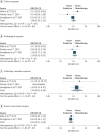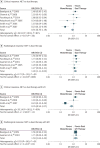Neoadjuvant Endocrine Therapy for Estrogen Receptor-Positive Breast Cancer: A Systematic Review and Meta-analysis
- PMID: 27367583
- PMCID: PMC5738656
- DOI: 10.1001/jamaoncol.2016.1897
Neoadjuvant Endocrine Therapy for Estrogen Receptor-Positive Breast Cancer: A Systematic Review and Meta-analysis
Abstract
Importance: Estrogen receptor-positive (ER+) tumors of the breast are generally highly responsive to endocrine treatment. Although endocrine therapy is the mainstay of adjuvant treatment for ER+ breast cancer, the role of endocrine therapy in the neoadjuvant setting is unclear.
Objective: To evaluate the effect of neoadjuvant endocrine therapy (NET) on the response rate and the rate of breast conservation surgery (BCS) for ER+ breast cancer.
Data sources: Based on PRISMA guidelines, a librarian-led search of PubMed and Ovid MEDLINE was performed to identify eligible trials published from inception to May 15, 2015. The search was performed in May 2015.
Study selection: Inclusion criteria were prospective, randomized, neoadjuvant clinical trials that reported response rates with at least 1 arm incorporating NET (n = 20). Two authors independently analyzed the studies for inclusion.
Data extraction and synthesis: Pooled odds ratios (ORs), 95% CIs, and P values were estimated for end points using the fixed- and random-effects statistical model.
Results: The analysis included 20 studies with 3490 unique patients. Compared with combination chemotherapy, NET as monotherapy with aromatase inhibitors had a similar clinical response rate (OR, 1.08; 95% CI, 0.50-2.35; P = .85; n = 378), radiological response rate (OR, 1.38; 95% CI, 0.92-2.07; P = .12; n = 378), and BCS rate (OR, 0.65; 95% CI, 0.41-1.03; P = .07; n = 334) but with lower toxicity. Aromatase inhibitors were associated with a significantly higher clinical response rate (OR, 1.69; 95% CI, 1.36-2.10; P < .001; n = 1352), radiological response rate (OR, 1.49; 95% CI, 1.18-1.89; P < .001; n = 1418), and BCS rate (OR, 1.62; 95% CI, 1.24-2.12; P < .001; n = 918) compared with tamoxifen. Dual combination therapy with growth factor pathway inhibitors was associated with a higher radiological response rate (OR, 1.59; 95% CI, 1.04-2.43; P = .03; n = 355), but not clinical response rate (OR, 0.76; 95% CI, 0.54-1.07; P = .11; n = 537), compared with endocrine monotherapy. The incidence of pathologic complete response was low (<10%).
Conclusions and relevance: Neoadjuvant endocrine therapy, even as monotherapy, is associated with similar response rates as neoadjuvant combination chemotherapy but with significantly lower toxicity, suggesting that NET needs to be reconsidered as a potential option in the appropriate setting. Additional research is needed to develop rational NET combinations and predictive biomarkers to personalize the optimal neoadjuvant strategy for ER+ breast cancer.
Conflict of interest statement
Figures



Comment in
-
Case Study of Early-Stage Breast Cancer Treatment During the COVID-19 Pandemic.Oncology (Williston Park). 2020 Nov 12;34(11):490-493. Oncology (Williston Park). 2020. PMID: 33206988 No abstract available.
References
-
- Rastogi P, Anderson SJ, Bear HD, et al. Preoperative chemotherapy: updates of National Surgical Adjuvant Breast and Bowel Project protocols B-18 and B-27. J Clin Oncol. 2008;26(5):778–785. - PubMed
-
- Bardia A, Baselga J. Neoadjuvant therapy as a platform for drug development and approval in breast cancer. Clin Cancer Res. 2013;19(23):6360–6370. - PubMed
-
- Mauri D, Pavlidis N, Ioannidis JPA. Neoadjuvant versus adjuvant systemic treatment in breast cancer: a meta-analysis. J Natl Cancer Inst. 2005;97(3):188–194. - PubMed
Publication types
MeSH terms
Substances
Grants and funding
LinkOut - more resources
Full Text Sources
Other Literature Sources
Medical

